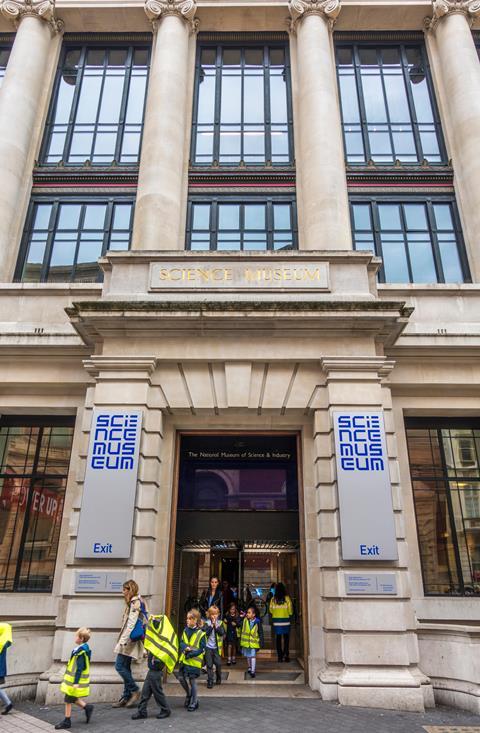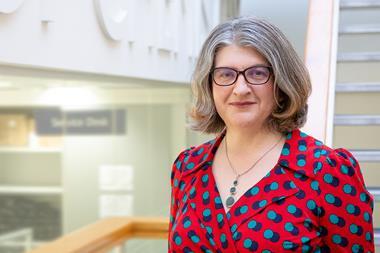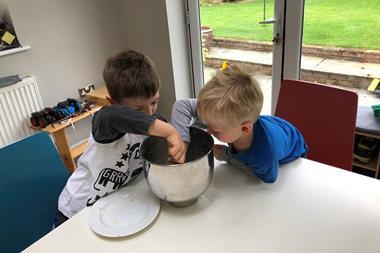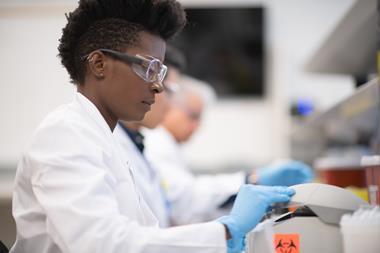Rachel Brazil reports on the RSC’s five-year project to see whether students from disadvantaged backgrounds can be encouraged to study chemistry
There was once a perception that chemistry was more meritocratic than other subjects. With its industrial roots, it was seen as a subject where bright kids from poorer backgrounds could succeed. Today the situation has changed and chemistry degrees and careers seem out of reach for many students from disadvantaged backgrounds. In an ambitious five-year £1 million project, Chemistry for All, the Royal Society of Chemistry has experimented with interventions that could help these students aspire to study chemistry. A report from the accompanying research team has been published and, despite many difficulties, ‘the most important finding was that all the money and effort that the RSC [invested] worked’ according to one of the report’s authors, Michael Reiss of University College London’s Institute of Education.
Having previously funded many pioneering chemistry outreach projects, in 2014 the RSC decided it wanted to go a step further. ‘We wanted to be working towards a point where the UK [chemistry] undergraduate population mirrored the UK population,’ explains Nicole Morgan, the RSC’s strategy and impact lead. ‘In order to achieve that, we really needed to understand what was working and what wasn’t working in terms of outreach for young people, especially for those from low socio-economic backgrounds.’
Inequalities in education are not an issue for chemistry alone. 2018–19 data from the Higher Education Statistics Agency shows that only 11.4% of undergraduate students are from the ‘low participation areas’ that represent 20% of the population. The figure for physical science students is below that, at 10.3%. More worrying, according to Lee Elliot Major, professor of social mobility at the University of Exeter, is the increasing gap in attainment between advantaged and disadvantaged students. ‘The higher you go up the achievement spectrum, the more extreme the gaps are,’ he explains. For example, in 2017, only 16% of those graduating from elite universities were from the poorest population quintile, but 55% from the richest. From 1981 and 2017 that gap has nearly trebled from 14% to 39%.
Education researchers have been looking at why students from disadvantaged backgrounds seem to turn away from science, and UCL sociologist Louise Archer has suggested it is linked to their lack of ‘science capital’. This concept proposes that students with more exposure to science through family interests and contacts are more likely to continue their science education when it is no longer compulsory.
‘When you look at people who continue with science [on average], they’re more likely to have had parents who [watch] David Attenborough [documentaries] on television.…[and] if they ever do go to a museum, might occasionally go to the Natural History Museum or Science Museum in London,’ explains Reiss. Students with low science capital tend to think science is just not for them.
We knew the students all had a great time when they came, but did it actually make any difference?
So could the RSC build science capital for students who are starting with very little and would this increase the likelihood that they would continue to study chemistry? This is what Chemistry for All set out to discover through a five-year programme of engagement with ‘difficult to reach’ schools, where chemistry outreach opportunities are less common. The RSC also commissioned a parallel research project, headed by Reiss, to probe the impact of the programme. ‘That’s what [had been] missing in previous studies of activities,’ says Morgan. ‘We knew [the students] all had a great time when they came, but did it actually make any difference?’
The programme

The RSC did not do this alone, but with three university-based chemistry outreach teams: Liverpool John Moores, Reading and Southampton in partnership, and Nottingham Trent with several partners, including an organisation promoting creativity in learning called Ignite! ‘Those universities recruited six partner schools for the interventions … and three control schools, who weren’t having the intervention, but were similarly matched socio-economically,’ explains education consultant and Chemistry for All project manager, Angela Hall.
The schools were selected from areas that represent the bottom 40% of the country with respect to levels of university attendance. Two student cohorts went through the programme from year 8 (12–13 year olds) to either year 11 or 12 (15–16 or 16–17 year olds) and the research team spent five years surveying students in both participating and control schools to monitor how student altitudes changed – if at all.
Each of the three university teams took different approaches. ‘Reading with Southampton focused on after school clubs called chemistry crew clubs as their main intervention, [but] Liverpool John Moores focused on interventions that they could run in chemistry lessons in the timetable,’ says Hall. Several teams ran events at the universities, including Liverpool John Moores’ forensics programme, focused on a fictitious murder scene that students were asked to solve using a range of forensic laboratory tests.
Karen Moss, head of the department of chemistry and forensics at Nottingham Trent, recalls the positive reactions of students meeting current PhD and undergraduate students. ‘A big chunk of what we were trying to do was just getting [the students] to meet people [studying science] and find out that they were human beings and that they were things that they might do that were interesting. We also tried to demystify what it was like to apply for university,’ says Moss.
Teacher turnover meant that over the five years they might be working with three or four different teachers
The idea was to try and retain a cohort of students who would participate over the life of the programme, but the teams had to deal with varying levels of interest from the students, particularly as they got older. David Read, director of chemistry outreach at Southampton, says their programmes started with science clubs but they had to change tactics as the students got older, ‘because science clubs aren’t cool if you’re in year 10!’ They shifted to organising industrial visits to companies like Thames water or Syngenta.
Nottingham Trent and their partner tried to emphasise the creative and experimental side of chemistry, giving students a chance to design their own experiments and introducing students and teachers to artists to ‘harness their creative energy’. In one session, chemistry experiments were choreographed to music; in another, teachers worked with an animator to make a cartoon based on the periodic table. ‘We created mobiles, once with a group of teachers, based on the work of [sculptor] Alexander Calder,’ remembers Rick Hall, founder of Ignite! Their interventions culminated in the ‘creative sparks’ initiative to develop the talent of eight exceptionally creative sixth formers.
Despite the enthusiasm of all involved, it was not easy and not everything worked. One of the main issues for all the teams was communicating with teachers. ’It was a real battle, and I think that’s quite demoralising for the people that were involved,’ says Read. Teacher turnover meant that over the five years they might be working with three or four different teachers, all new to the project. ‘The project officer used to spend hours and hours and hours chasing people up about emails she’d sent multiple times.’ But this is not a criticism. ‘The teachers in those schools have so many demands on their time, they didn’t have time to claim resources that we had allocated,’ he concedes.
Student interest was also variable. For the Southampton schools, attendance ranged from 6–30 students, says Read. ‘We were in the kinds of schools where kids wanted to do it, but there are so many other things going on in their lives that staying behind at the end of school to do this wasn’t always top of their priority list.’
The difficulties led to a fourth university partner dropping out after a year. Some of the schools initially recruited also dropped out, and the problem was worse for the control group schools. ‘The universities did offer outreach for different cohorts [in control schools],’ says Hall, but ‘they kept on dropping out or they didn’t respond and it was even more difficult to get [the student] surveys [completed]’.
Shifting attitudes
There was a point a couple of years into the study when Reiss was worried that any effect of the interventions were going to be minute – or maybe they would have no impact at all. But this wasn’t the case. ‘There were some quite substantial differences that these interventions made. We had more young people being really positive about chemistry, and saying that they were going to go on and study chemistry after GCSEs,’ he says.
This trial is much more scientifically rigorous than most trials in this area. We need more trials like this
The headline figures from the Institute of Education study show that in Year 11, 23.2% of students who participated in the Chemistry for All programme intended to continue to study chemistry at A-Level or equivalent, compared to 18.5% of students in control schools. From Year 8 to Year 11, students’ views of chemistry became less positive – which is characteristic for science subjects as children grow older – but the research found that the changes were smaller for the Chemistry for All cohort.
‘What’s really wonderful about this trial is that it’s much more scientifically rigorous than most trials in this area. We need more trials like this,’ says Elliot Major, who provided input to the project in its very early days. The crucial element is the control group. ‘Unless you have a comparison group … you can’t infer any causal impact,’ he says.
Those on the front line also felt they really made a difference. While the numbers of students they worked with over the five years was lower than hoped in some cases, it had a huge impact on those that did engage. ‘I know from speaking to some of the kids that it was transformative,’ says Read. ‘I love going to [more advantaged] schools where there is a massive groups of enthusiastic kids in front of you, but you know that those kids are going to be going to Winchester Science Centre with their parents in the school holiday. It makes a bigger difference when you are the one opportunity.’
‘What seems to be really important was continuity over the years,’ concludes Reiss, which backs up what other research has suggested. ‘One-off events, however well-funded and -run, are far less likely to have an effect than working with the same school [or] group of students over at least a couple of years.’
Another important lesson learnt was that the type of activities mattered less than working with schools to deliver them in a tailored way. ‘We saw most successes [for] the universities who worked hand in hand with the schools,’ says Sarah Robertson, director of education and professional practice at the RSC. ‘Coming into these schools with a ready-made a solution to their perceived problem is not the way to do it. The much more effective way is to work with the teachers in the school to understand their individual situations.’
Extrinsic value
One element the research team probed was how students were making decisions on the subjects they were choosing to study. Did they purely pick the subject they found most enjoyable? ‘This was one of my surprises,’ says Reiss, ‘I belong to the slightly idealistic generation who genuinely chose [their] A-levels and what I was going to study at university because I so enjoyed the subject – that is now a minority position.’ Instead Reiss found that students are more likely to continue to study chemistry if they think it has ‘extrinsic value’ – that it will provide some sort of benefit, usually a satisfying, well-paid career.

This means successful outreach needs to be more than entertaining. ‘You need to engage students and that should be enjoyable,’ says Hall. ‘But it isn’t just about having fun, this is about getting students to deeply engage with the challenges of chemistry and excitement of chemistry, which is different from just letting off a lot of explosions and they all cheer.’ This kind of engagement seems to develop by linking chemistry to the real world.
The message that you’ve got to be innately clever is particularly harmful for young women
The importance of extrinsic motivation also points to the need for better careers information for students and building this into outreach programmes. ‘The only things students seem to think you can do with chemistry is either read medicine at university, or become a chemist [pharmacist] or a chemistry teacher. They don’t realize the diversity of jobs,’ says Reiss. ‘Nor do they realize you will have an above average salary.’
The study also considered how gender affects students’ aspiration and interest in chemistry. In 2018/19, only 45% of chemistry undergraduates were female, compared to 57% of the total undergraduate population. ‘There is still a perception [that chemistry is not for girls], which sometimes even in schools tends to dribble through,’ says Reiss. His analysis showed that overall boys tended to express more positive views than girls, but Chemistry for All seemed to have an equalising effect in at least one of the cohorts studied. At Year 11, 12.3% of girls and 24.5% of boys agreed or strongly agreed that they intended to continue to study chemistry within comparison schools, but this shifted to 26.5% of girls and 25.3% of boys within schools in the Chemistry for All programme
One attitude expressed that Reiss says is damaging to girls’ aspirations is the idea that chemistry is difficult. ‘The message that you’ve got to be innately clever is particularly harmful for young women.’ Some will argue that sciences are hard, and it’s certainly true that students who study the three sciences on average gain lower A-level grades than some other subjects. But Reiss argues that ‘it’s not helpful, because it’s not true for some students’. This also ignores the fact that whatever your A-level grades, lifetime earnings for chemistry graduates will typically exceed many other subjects.
The future
Chemistry for All has demonstrated it is possible to change students’ attitudes through carefully considered outreach, but questions remain. ‘If you raise aspirations in this way, does it actually translate into “bums on seats”?’ asks Elliot Major. Will more of those students who participated in Chemistry for All go on to study chemistry when they leave school? The story is not yet complete – something the RSC has acknowledged by commissioning Reiss and his colleges to follow up with the same cohort of students in 2021 to see what university or career decisions they have made.
Do something you believe is going to make a difference, engage students and keep at it
In the meantime, Robertson says the RSC is sharing the current conclusions with the chemistry outreach community and is launching a new chemistry outreach grant scheme to allow providers to build on the findings. ‘We’re also reviewing our approach to outreach on the basis of the findings, and other evidence that we have, to make sure that the outreach that we do is effective and as targeted as it can be on widening participation,’ she says.
Chemistry for All has been a bold experiment and a significant investment for the RSC, but there are lessons for all. ‘The message to do something you believe is going to make a difference, and engage students and keep on at it for at least a couple of years, is something that, frankly, even a small charity could do,’ says Reiss.
Although the mesage is positive, Elliot Major does see limitations to the impact of such outreach programmes. ‘Social mobility is driven by inequalities outside the school gates as well as inside them,’ he says. Absolute rates of social mobility have declined and he fears that for young people living through the Covid-19 crisis, their chances of climbing the social ladder will be diminished even further. ‘Obviously it’s not a panacea for all society’s ills,’ admits Morgan. ‘But it shows that there are things that you can do and if you understand how young people are engaging with science, then you can start changing the narrative.’
Rachel Brazil is a science writer based in London, UK













No comments yet